 CA/OR/WA 04/09–04/25, 2010 - 59 LHs, 2 LShips, 9 Fresnels, 2 Faux LHs, 4 Canadian LHs
#68578
06/20/10 07:39 PM CA/OR/WA 04/09–04/25, 2010 - 59 LHs, 2 LShips, 9 Fresnels, 2 Faux LHs, 4 Canadian LHs
#68578
06/20/10 07:39 PM
|
Joined: Dec 2002
Posts: 1,964
sandy
 OP
OP
Cruise Director
|
OP

Cruise Director
Joined: Dec 2002
Posts: 1,964 |
CALIFORNIA (34 LHs, 7 Fresnels, 1 LShip, 2 Faux LHs): Prior to joining 37 other USLHS members on a bus tour to see 12 northern CA lighthouses that began on Sunday, 4/11, Stan and I took a self-guided tour of the USS Midway Aircraft Carrier in San Diego. I stopped to read the sign telling of the 1980 collision between the Panamanian freighter named “Cactus” and the carrier. I was intrigued by the following excerpt: “Shortly after 20:00 that night (8pm), the bow of the Cactus slid underneath the Midway’s massive flight deck overhang, the freighter’s structure demolishing the tail sections of several Phantom jets on the flight deck and carrying away or destroying antennas and the Fresnel Lens platform.” The picture that follows is the Fresnel Lens platform: 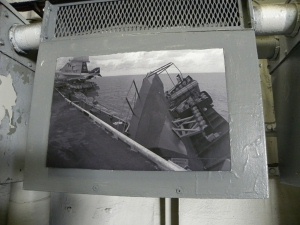 And here I thought the term Fresnel Lens only related to optics in lighthouses. . . . Mary Lee & Skip Sherwood were the USLHS reps and our hosts for the northern CA leg of our trip. They provided everyone with a detailed itinerary and exceptionally well thought-out schedules and impressed me with their organizational skills.. We left from the San Diego, CA hotel we stayed at Saturday night to see Old Point Loma and New Point Loma lighthouses: 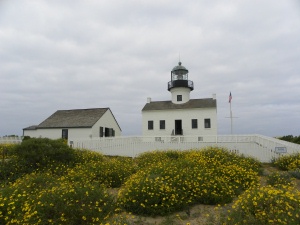 Old Point Loma–the tower was too small to accommodate a 1st-Order Fresnel lens that it was to receive originally and the fixed 3rd-Order lens intended for Humboldt Bay was installed instead. The 1st-Order lens was installed at Cape Flattery in Washington State. Today’s restored Old Point Loma Lighthouse has the 3rd-Order Fresnel lens from another California lighthouse, namely Mile Rocks: 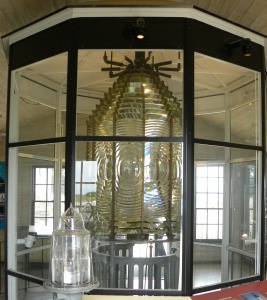 The replica assistant keeper’s dwelling is a museum and houses the 3rd-Order Fresnel lens from the New Point Loma Lighthouse, shown above, and the 5th-Order Fresnel Lens (shown below) from the Ballast Point Light, established in 1890 as a harbor light. Together, Ballast Point and the New Point Loma Light replaced the Old Point Loma Light which was too frequently obscured by fog. Ballast Point was a Victorian structure identical in design to the light at San Luis Obispo, which was lit the same year. 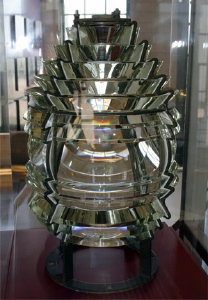 Fog, isolation of the site, and cramped living quarters made staffing problematic. These issues all contributed to the station only being active from 1855 until 1891 when a new light and much larger station, New Point Loma, was erected at a lower elevation on the same point.. 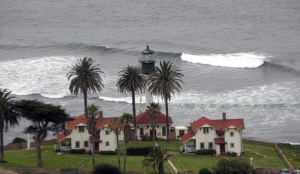 New Point Loma We then left for San Juan Capistrano where we lunched and had a self-guided audio tour of the mission located there before departing for Long Beach, CA where we dined and stayed overnight on the Queen Mary: 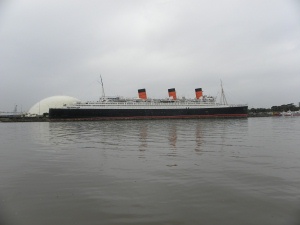 Following breakfast, we boarded the bus for a boat tour of Long Beach Harbor that included views of the harbor and 2 lighthouses–Los Angeles Harbor (Angel’s Gate) and Long Beach Harbor (Robot) Light and 2 faux lights–Parker’s Restaurant and Lions Lighthouse for Sight: 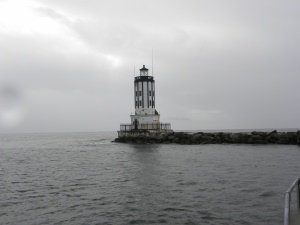 Los Angeles Harbor (Angel’s Gate) Lighthouse–built around 12 steel columns, the bottom of the lighthouse is octagonal and the top 3 stories are cylindrical. The 12 columns, covered with black pilasters are unique and no other lighthouse has ever been built to this design. 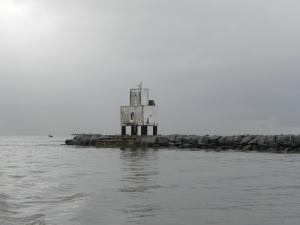 Long Beach Harbor (Robot) Lighthouse–this 3-story, monolithic structure is built of concrete and rests on a base of 6 columns. It was designed to withstand earthquakes and seismic tidal waves, and replaced an earlier skeleton tower. It has never been manned and was initially controlled remotely from the much more esthetically-pleasing Los Angeles Harbor Lighthouse.
|
|
|
|
Entire Thread
|

 CA/OR/WA 04/09–04/25, 2010 - 59 LHs, 2 LShips, 9 Fresnels, 2 Faux LHs, 4 Canadian LHs
CA/OR/WA 04/09–04/25, 2010 - 59 LHs, 2 LShips, 9 Fresnels, 2 Faux LHs, 4 Canadian LHs
|
sandy
|
06/20/10 11:39 PM
|

 Re: CA/OR/WA 04/09–04/25, 2010 - 59 LHs, 2 LShips, 9 Fresnels, 2 Faux LHs, 4 Canadian LHs
Re: CA/OR/WA 04/09–04/25, 2010 - 59 LHs, 2 LShips, 9 Fresnels, 2 Faux LHs, 4 Canadian LHs
|
sandy
|
06/20/10 11:39 PM
|

 Re: CA/OR/WA 04/09–04/25, 2010 - 59 LHs, 2 LShips, 9 Fresnels, 2 Faux LHs, 4 Canadian LHs
Re: CA/OR/WA 04/09–04/25, 2010 - 59 LHs, 2 LShips, 9 Fresnels, 2 Faux LHs, 4 Canadian LHs
|
sandy
|
06/20/10 11:40 PM
|

 Re: CA/OR/WA 04/09–04/25, 2010 - 59 LHs, 2 LShips, 9 Fresnels, 2 Faux LHs, 4 Canadian LHs
Re: CA/OR/WA 04/09–04/25, 2010 - 59 LHs, 2 LShips, 9 Fresnels, 2 Faux LHs, 4 Canadian LHs
|
sandy
|
06/20/10 11:40 PM
|

 Re: CA/OR/WA 04/09–04/25, 2010 - 59 LHs, 2 LShips, 9 Fresnels, 2 Faux LHs, 4 Canadian LHs
Re: CA/OR/WA 04/09–04/25, 2010 - 59 LHs, 2 LShips, 9 Fresnels, 2 Faux LHs, 4 Canadian LHs
|
sandy
|
06/20/10 11:40 PM
|

 Re: CA/OR/WA 04/09–04/25, 2010 - 59 LHs, 2 LShips, 9 Fresnels, 2 Faux LHs, 4 Canadian LHs
Re: CA/OR/WA 04/09–04/25, 2010 - 59 LHs, 2 LShips, 9 Fresnels, 2 Faux LHs, 4 Canadian LHs
|
sandy
|
06/20/10 11:52 PM
|

 Re: CA/OR/WA 04/09–04/25, 2010 - 59 LHs, 2 LShips, 9 Fresnels, 2 Faux LHs, 4 Canadian LHs
Re: CA/OR/WA 04/09–04/25, 2010 - 59 LHs, 2 LShips, 9 Fresnels, 2 Faux LHs, 4 Canadian LHs
|
sandy
|
06/20/10 11:52 PM
|

 Re: CA/OR/WA 04/09–04/25, 2010 - 59 LHs, 2 LShips, 9 Fresnels, 2 Faux LHs, 4 Canadian LHs
Re: CA/OR/WA 04/09–04/25, 2010 - 59 LHs, 2 LShips, 9 Fresnels, 2 Faux LHs, 4 Canadian LHs
|
sandy
|
06/20/10 11:52 PM
|

 Re: CA/OR/WA 04/09–04/25, 2010 - 59 LHs, 2 LShips, 9 Fresnels, 2 Faux LHs, 4 Canadian LHs
Re: CA/OR/WA 04/09–04/25, 2010 - 59 LHs, 2 LShips, 9 Fresnels, 2 Faux LHs, 4 Canadian LHs
|
sandy
|
06/21/10 12:07 AM
|

 Re: CA/OR/WA 04/09–04/25, 2010 - 59 LHs, 2 LShips, 9 Fresnels, 2 Faux LHs, 4 Canadian LHs
Re: CA/OR/WA 04/09–04/25, 2010 - 59 LHs, 2 LShips, 9 Fresnels, 2 Faux LHs, 4 Canadian LHs
|
WackoPaul
|
06/21/10 02:21 AM
|

 Re: CA/OR/WA 04/09–04/25, 2010 - 59 LHs, 2 LShips, 9 Fresnels, 2 Faux LHs, 4 Canadian LHs
Re: CA/OR/WA 04/09–04/25, 2010 - 59 LHs, 2 LShips, 9 Fresnels, 2 Faux LHs, 4 Canadian LHs
|
Lorie Roe
|
06/21/10 03:50 PM
|

 Re: CA/OR/WA 04/09–04/25, 2010 - 59 LHs, 2 LShips, 9 Fresnels, 2 Faux LHs, 4 Canadian LHs
Re: CA/OR/WA 04/09–04/25, 2010 - 59 LHs, 2 LShips, 9 Fresnels, 2 Faux LHs, 4 Canadian LHs
|
kory63
|
06/21/10 04:18 PM
|

 Re: CA/OR/WA 04/09–04/25, 2010 - 59 LHs, 2 LShips, 9 Fresnels, 2 Faux LHs, 4 Canadian LHs
Re: CA/OR/WA 04/09–04/25, 2010 - 59 LHs, 2 LShips, 9 Fresnels, 2 Faux LHs, 4 Canadian LHs
|
wvlights0
|
06/21/10 07:03 PM
|

 Re: CA/OR/WA 04/09–04/25, 2010 - 59 LHs, 2 LShips, 9 Fresnels, 2 Faux LHs, 4 Canadian LHs
Re: CA/OR/WA 04/09–04/25, 2010 - 59 LHs, 2 LShips, 9 Fresnels, 2 Faux LHs, 4 Canadian LHs
|
sandy
|
06/21/10 10:41 PM
|

 Re: CA/OR/WA 04/09–04/25, 2010 - 59 LHs, 2 LShips, 9 Fresnels, 2 Faux LHs, 4 Canadian LHs
Re: CA/OR/WA 04/09–04/25, 2010 - 59 LHs, 2 LShips, 9 Fresnels, 2 Faux LHs, 4 Canadian LHs
|
MrsTLC
|
06/21/10 10:49 PM
|

 Re: CA/OR/WA 04/09–04/25, 2010 - 59 LHs, 2 LShips, 9 Fresnels, 2 Faux LHs, 4 Canadian LHs
Re: CA/OR/WA 04/09–04/25, 2010 - 59 LHs, 2 LShips, 9 Fresnels, 2 Faux LHs, 4 Canadian LHs
|
Bill and Judy
|
06/22/10 02:15 AM
|

 Re: CA/OR/WA 04/09–04/25, 2010 - 59 LHs, 2 LShips, 9 Fresnels, 2 Faux LHs, 4 Canadian LHs
Re: CA/OR/WA 04/09–04/25, 2010 - 59 LHs, 2 LShips, 9 Fresnels, 2 Faux LHs, 4 Canadian LHs
|
rscroope
|
06/22/10 06:51 PM
|

 Re: CA/OR/WA 04/09–04/25, 2010 - 59 LHs, 2 LShips, 9 Fresnels, 2 Faux LHs, 4 Canadian LHs
Re: CA/OR/WA 04/09–04/25, 2010 - 59 LHs, 2 LShips, 9 Fresnels, 2 Faux LHs, 4 Canadian LHs
|
sandy
|
06/22/10 11:49 PM
|

 Re: CA/OR/WA 04/09–04/25, 2010 - 59 LHs, 2 LShips, 9 Fresnels, 2 Faux LHs, 4 Canadian LHs
Re: CA/OR/WA 04/09–04/25, 2010 - 59 LHs, 2 LShips, 9 Fresnels, 2 Faux LHs, 4 Canadian LHs
|
Lighthouse Loon
|
06/23/10 12:06 AM
|

 Re: CA/OR/WA 04/09–04/25, 2010 - 59 LHs, 2 LShips, 9 Fresnels, 2 Faux LHs, 4 Canadian LHs
Re: CA/OR/WA 04/09–04/25, 2010 - 59 LHs, 2 LShips, 9 Fresnels, 2 Faux LHs, 4 Canadian LHs
|
sandy
|
06/30/10 06:59 AM
|

 Re: CA/OR/WA 04/09–04/25, 2010 - 59 LHs, 2 LShips, 9 Fresnels, 2 Faux LHs, 4 Canadian LHs
Re: CA/OR/WA 04/09–04/25, 2010 - 59 LHs, 2 LShips, 9 Fresnels, 2 Faux LHs, 4 Canadian LHs
|
sandy
|
06/30/10 07:00 AM
|

 Re: CA/OR/WA 04/09–04/25, 2010 - 59 LHs, 2 LShips, 9 Fresnels, 2 Faux LHs, 4 Canadian LHs
Re: CA/OR/WA 04/09–04/25, 2010 - 59 LHs, 2 LShips, 9 Fresnels, 2 Faux LHs, 4 Canadian LHs
|
WackoPaul
|
06/30/10 03:50 PM
|

 Re: CA/OR/WA 04/09–04/25, 2010 - 59 LHs, 2 LShips, 9 Fresnels, 2 Faux LHs, 4 Canadian LHs
Re: CA/OR/WA 04/09–04/25, 2010 - 59 LHs, 2 LShips, 9 Fresnels, 2 Faux LHs, 4 Canadian LHs
|
rscroope
|
06/30/10 07:57 PM
|

 Re: CA/OR/WA 04/09–04/25, 2010 - 59 LHs, 2 LShips, 9 Fresnels, 2 Faux LHs, 4 Canadian LHs
Re: CA/OR/WA 04/09–04/25, 2010 - 59 LHs, 2 LShips, 9 Fresnels, 2 Faux LHs, 4 Canadian LHs
|
wvlights0
|
07/01/10 02:45 AM
|

 Re: CA/OR/WA 04/09–04/25, 2010 - 59 LHs, 2 LShips, 9 Fresnels, 2 Faux LHs, 4 Canadian LHs
Re: CA/OR/WA 04/09–04/25, 2010 - 59 LHs, 2 LShips, 9 Fresnels, 2 Faux LHs, 4 Canadian LHs
|
sandy
|
07/01/10 03:53 AM
|

 Re: CA/OR/WA 04/09–04/25, 2010 - 59 LHs, 2 LShips, 9 Fresnels, 2 Faux LHs, 4 Canadian LHs
Re: CA/OR/WA 04/09–04/25, 2010 - 59 LHs, 2 LShips, 9 Fresnels, 2 Faux LHs, 4 Canadian LHs
|
fra02441
|
07/01/10 02:04 PM
|

 Re: CA/OR/WA 04/09–04/25, 2010 - 59 LHs, 2 LShips, 9 Fresnels, 2 Faux LHs, 4 Canadian LHs
Re: CA/OR/WA 04/09–04/25, 2010 - 59 LHs, 2 LShips, 9 Fresnels, 2 Faux LHs, 4 Canadian LHs
|
sandy
|
07/02/10 07:06 AM
|

 Re: CA/OR/WA 04/09–04/25, 2010 - 59 LHs, 2 LShips, 9 Fresnels, 2 Faux LHs, 4 Canadian LHs
Re: CA/OR/WA 04/09–04/25, 2010 - 59 LHs, 2 LShips, 9 Fresnels, 2 Faux LHs, 4 Canadian LHs
|
sandy
|
07/11/10 05:52 AM
|

 Re: CA/OR/WA 04/09–04/25, 2010 - 59 LHs, 2 LShips, 9 Fresnels, 2 Faux LHs, 4 Canadian LHs
Re: CA/OR/WA 04/09–04/25, 2010 - 59 LHs, 2 LShips, 9 Fresnels, 2 Faux LHs, 4 Canadian LHs
|
sandy
|
07/11/10 05:52 AM
|

 Re: CA/OR/WA 04/09–04/25, 2010 - 59 LHs, 2 LShips, 9 Fresnels, 2 Faux LHs, 4 Canadian LHs
Re: CA/OR/WA 04/09–04/25, 2010 - 59 LHs, 2 LShips, 9 Fresnels, 2 Faux LHs, 4 Canadian LHs
|
sandy
|
07/11/10 05:52 AM
|

 Re: CA/OR/WA 04/09–04/25, 2010 - 59 LHs, 2 LShips, 9 Fresnels, 2 Faux LHs, 4 Canadian LHs
Re: CA/OR/WA 04/09–04/25, 2010 - 59 LHs, 2 LShips, 9 Fresnels, 2 Faux LHs, 4 Canadian LHs
|
WackoPaul
|
07/11/10 04:44 PM
|
|
|
|
Forums39
Topics16,978
Posts184,640
Members2,579
| |
Most Online10,155
Jan 14th, 2020
|
|
|
0 registered members (),
1,142
guests, and 1
spider. |
|
Key:
Admin,
Global Mod,
Mod
|
|
|

